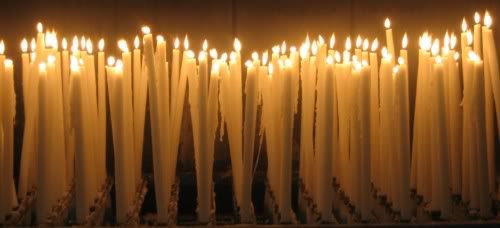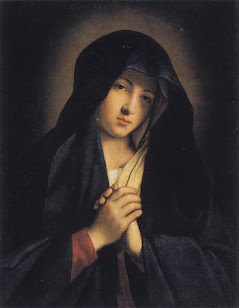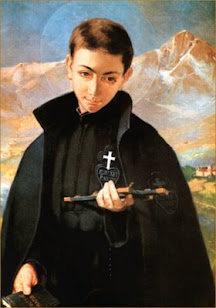We continue our re-publishing of previous posts chronicling the miraculous unfolding of events that took place at Lourdes in 1858. For an introduction to the series, see here. Our Lady of Lourdes, pray for us!
On February 25, we remember the ninth apparition of Our Blessed Mother to Saint Bernadette Soubirous at the grotto in Lourdes. Beginning on February 11, 1858, The Blessed Virgin appeared to Bernadette Soubirous a total of 18 times bringing a message of prayer, penance, poverty, and participation. Through these posts, we continue our journey with Saint Bernadette as we encounter Our Blessed Mother through her eyes, memories, and words. The previous seven visitations (February 11, 14, 18, 19, 20, 21, and 23) were preludes to what was to begin during the eighth (2/24) blessed message of Mary—during which she told Saint Bernadette to offer “Penance, penance, penance,” and to “Pray to God for sinners.” During that visit, the Blessed Virgin also asked Bernadette to kiss the ground in penance for the sins of the world.
On February 25, 1858, Bernadette returned to the grotto, accompanied by her mother and a crowd of over 300 people. Following the message of Mary given on the previous day, Bernadette offered herself and her prayers as penance for sinners. She knelt outside the grotto, and moved to her customary place on her knees, rather than by walking. As was her custom, blessed candle burning, she knelt and prayed the Rosary, and was graced again by the appearance of aquero, the beautiful lady in the recess on the rock face. At the conclusion of the Rosary, the Blessed Mother spoke to Bernadette. She asked, “Would you kiss the ground for sinners?” Bernadette did not audibly answer, but instead, to the surprise of those gathered, began to kiss the ground in front of her. The Blessed Mother continued, “Would you eat the grass for sinners?” Again, to the shock of the crowds gathered, Bernadette moved on her knees further into the grotto, eating the sparse grass that grew like the wild pigs who foraged there.
In a miraculous turn, the Blessed Mother then told Saint Bernadette, “Go drink at the spring and wash yourself there.” Bernadette was confused, as there was no spring in the grotto, and turned to move to the Gave River, which was only yards away—the same river she had refused to cross with her sister and friend on the date of the first apparition. The Blessed Mother corrected her, gesturing for Bernadette to come into the grotto further, finding herself in front of a small pool of muddy water. She scratched the earth a few times to get enough water to drink, and then both drank it and washed herself with it, smearing mud across her face. The onlookers took this as final proof that the simple miller’s daughter was mad. The authorities, however, were outraged.
In her personal journal, Saint Bernadette recounts the events of the ninth apparition. In her own words: “She also asked me to go drink from the spring and wash there; since I did not see a spring, I started toward the Gave. She said that that was not the right place and she pointed to another place, showing me the spring under the Grotto. I went to the place she showed me, but all I saw was a tiny bit of muddy water. There was so little of it that I was hardly able to get any of it in my hands. Nevertheless, I obeyed and started digging with my hands. I tried to drink it, but it was so dirty that the first three times, it came back up. On the fourth try, I was able to drink a little of it.”
During four visitations from Mary (9-12), Saint Bernadette carried out the same actions—drinking from the spring, washing herself, eating grass, walking on her knees, and kissing the ground. Those around her do not understand, but as we reflect on her actions, we see they are biblical in nature. Because Our Lady of Lourdes asked her, Bernadette acts out the Incarnation, the Passion and the death of Christ.
Moving on her knees at the back of the Grotto recalls the Incarnation, God lowering himself to become human. Bernadette kisses the ground showing us that this act of humility is an action of the love God has for his people.
When Bernadette stoops and eats the dirty, bitter grasses growing in the recesses of the grotto, she re-enacts the Jewish Old Testament tradition of slaughtering a lamb, cleaning it, and filling it with bitter herbs. For the Jews, this showed that the Lamb of God had taken away the sins of the world, washed it clean, and taken on all bitterness unto himself.
Bernadette smeared her face with mud, suffering much as Isaiah had prophesied about Christ. "Because he carried on himself all our sins his face no longer appeared human." And, “He was" Isaiah continues, "like a lamb led to the slaughter, and on his way the crowd mocked him.” At the grotto, Bernadette “disfigures” her face with the mud of the spring, and the crowd mocks her and questions her sanity. She suffers the humiliation, in those moments, of Christ on the way to his cross.
Bernadette’s actions free the grotto—free it from the bitter grasses growing and hiding it’s beauty, free the holy spring beneath it. In a manner of speaking, she also frees us, the people who the message of Lourdes is intended. By her actions, the mysteries of the heart of Jesus are revealed: "The water that I shall give you will become, in you, a spring welling up to eternal life.” Our hearts are like the grass and mud of the grotto, wounded and soiled by sin. But we are freed by the message of Lourdes, remembering that at the bottom of each of our hearts, there is the life of God. “Penance, Penance, Penance!” calls us each to daily conversion.
Why pray the Rosary every day for a year?
Each time the Blessed Virgin has appeared-- whether it be to Saint Bernadette Soubirous at Lourdes; to Lucia, Jacinta, and Francisco at Fatima; or to Mariette Beco at Banneux-- she has asserted the importance, saving grace, and power of praying the Holy Rosary on a daily basis. Based upon her words, the Rosary is penance and conversion for sinners, a pathway to peace, an end to war, and a powerful act of faith in Jesus Christ. Pope Paul VI presented the Rosary as a powerful means to reach Christ "not merely with Mary but indeed, insofar as this is possible to us, in the same way as Mary, who is certainly the one who thought about Him more than anyone else has ever done."
To show us how this is done, perhaps no one has been more eloquent than the great Cardinal Newman, who wrote: "The great power of the Rosary consists in the fact that it translates the Creed into Prayer. Of course, the Creed is already in a certain sense a prayer and a great act of homage towards God, but the Rosary brings us to meditate again on the great truth of His life and death, and brings this truth close to our hearts. Even Christians, although they know God, usually fear rather than love Him. The strength of the Rosary lies in the particular manner in which it considers these mysteries, since all our thinking about Christ is intertwined with the thought of His Mother, in the relations between Mother and Son; the Holy Family is presented to us, the home in which God lived His infinite love."
As Mary said at Fatima, "Jesus wants to use you to make Me known and loved. He wishes to establish the devotion to My Immaculate Heart throughout the world. I promise salvation to whoever embraces it; these souls will be dear to God, like flowers put by Me to adorn his throne."

Subscribe to:
Post Comments (Atom)










0 comments:
Post a Comment
Thanks for leaving a comment. If you wish to submit a prayer request, however, please do so above, using the "Contact" tab.